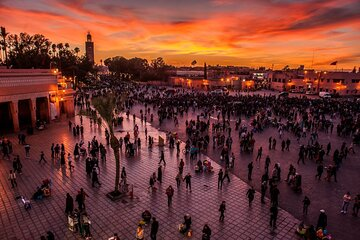- Published on
The Ancient Art of Storytelling in Jemaa el-Fnaa, Marrakech
- Authors

- Name
- Adil ABBADI
Introduction

Nestled in the heart of Marrakech, Jemaa el-Fnaa is a bustling square that pulsates with the rhythm of ancient storytelling. This iconic spot has been the epicenter of Moroccan folklore and tradition for centuries, where the art of storytelling has been passed down through generations. In this article, we'll delve into the rich cultural heritage of Jemaa el-Fnaa, exploring the significance of storytelling in Moroccan culture and the captivating tales that bring this vibrant square to life.
- Historical Context
- Traditional Significance of Storytelling
- Modern Relevance of Storytelling
- Cultural Preservation Efforts
- Conclusion
- Cultural Call-to-Action
Historical Context
Jemaa el-Fnaa's rich cultural tapestry is woven from the threads of Berber, Arab, and Andalusian influences. The square's name, "Jemaa el-Fnaa," translates to "assembly of the dead," a testament to its ancient origins as a gathering place for the city's inhabitants. Over time, the square evolved into a hub of artistic expression, where musicians, dancers, and traders converged to share their talents.
Traditional Significance of Storytelling
In Moroccan culture, storytelling is an integral part of oral tradition, where tales of legendary heroes, mythical creatures, and historical events are passed down through generations. These stories serve as a window into the country's rich cultural heritage, preserving the history and values of the Moroccan people.

In Jemaa el-Fnaa, the art of storytelling is elevated to an art form, with hakawati (storytellers) regaling audiences with epic tales of adventure, bravery, and wisdom. These masterful storytellers use their voices, gestures, and facial expressions to bring ancient legends to life, captivating listeners of all ages.
Modern Relevance of Storytelling
In an era of digital communication, the art of storytelling in Jemaa el-Fnaa remains a powerful tool for preserving cultural heritage and promoting cross-cultural understanding. The square's vibrant atmosphere, filled with the sounds of Gnawa music, the aroma of traditional cuisine, and the vibrant colors of local artisans, provides the perfect backdrop for storytelling to thrive.
Cultural Preservation Efforts
Recognizing the importance of Jemaa el-Fnaa's storytelling tradition, the Moroccan government, along with cultural organizations, has implemented initiatives to preserve and promote this cultural heritage. The establishment of the Jemaa el-Fnaa Cultural Space, a hub for traditional arts and crafts, has provided a platform for hakawati to share their art with a wider audience.

Additionally, the Marrakech International Storytelling Festival, held annually in Jemaa el-Fnaa, brings together storytellers from around the world to celebrate the art of storytelling in Jemaa el-Fnaa. This festival serves as a testament to the enduring power of storytelling in Moroccan culture.
Conclusion
The ancient art of storytelling in Jemaa el-Fnaa is a vibrant thread in the rich cultural tapestry of Morocco. This iconic square, nestled in the heart of Marrakech, provides a unique window into the country's rich cultural heritage, where ancient tales come alive through the art of storytelling.
Cultural Call-to-Action
As we delve into the mesmerizing world of Jemaa el-Fnaa's storytelling traditions, we're reminded of the importance of preserving cultural heritage for future generations. We invite you to immerse yourself in the vibrant atmosphere of Marrakech's iconic square, where ancient legends come alive through the art of storytelling.
